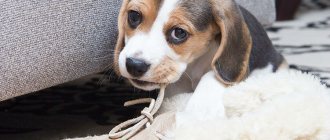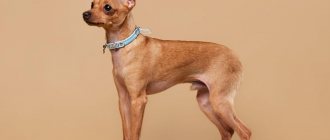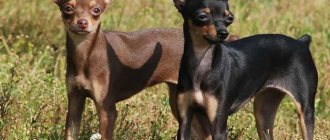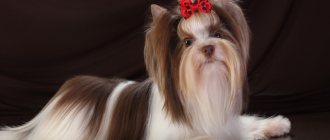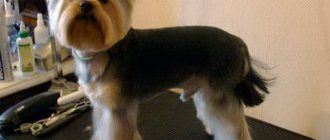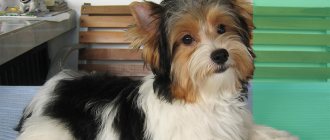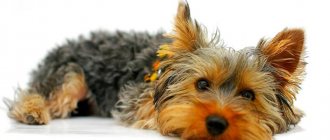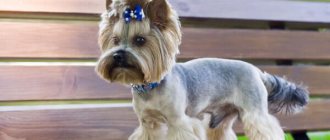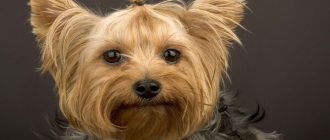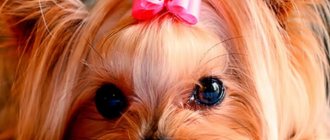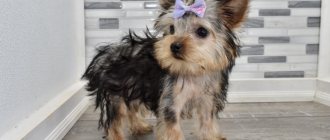York (Yorkshire Terrier) is one of the most famous decorative dogs on the entire planet. They are valued for their energetic character, unquestioning obedience and beautiful appearance. Originally bred for hunting, today it is used only for keeping in an apartment as a pet.
Its charming appearance hides the impulsive nature of the terrier, and its unique coat imposes serious maintenance requirements. In this article we will look at how to properly raise a Yorkshire Terrier, what is needed to maintain the health of the dog.
History of the origin of Yorkshire Terriers
The counties of Yorkshire and Lancashire, located in northern England, are considered the homeland of these dogs. The ancestor of modern Yorkies is the Waterside Terrier, which was popular among peasants. Breeding continued from the 17th to the 19th centuries; Maltese dogs were used for selection - from them the Yorkies inherited their long, silky hair. Thanks to numerous searches for a standard, in addition to the Yorkies, the Manchester Terrier was also bred.
The Yorkshire Terrier became most widespread among weavers working in new mechanized factories. The dog was used as a rat catcher in places where it was impossible to have cats (they spoiled yarn and wool in production). At that time, the dogs weighed 6-7 kg and had a longer and larger body. The Yorkshire Terrier received regulatory recognition in 1886, and a kennel club was organized 20 years later. The first representative appeared in Russia in 1971; today about 75 nurseries are registered throughout the country.
Yorkshire Terrier - description of the breed
The Yorkshire Terrier is one of the smallest dogs, their weight should not exceed 3.2 kg. Externally, it is distinguished by long hair, which should fall completely straight down the sides of the body. A healthy dog normally has not only compact size, but also graceful posture. The Yorkie's body should be strong and athletic, especially if the animal has systematic physical activity. Yorkshire terriers today are bred for decorative purposes; over many years of crossing, they have practically lost their hunting instincts, but they have retained the energy and curiosity inherent in the entire group.
Standard
Dog training standards were adopted in 1954 and have remained virtually unchanged to date. According to accepted rules, the size of a dog is limited only by the upper limit; there are no minimum requirements for weight and height. Basic criteria for assessing this breed:
Frame:
- The Yorkshire Terrier's body is very compact; its height should not exceed 20 cm.
- The loin is strong and developed, with convex ribs on the chest.
- The maximum weight is 3.2 kg; too small or large representatives are a defect, despite the popularity of Yorkshire terriers of non-standard size.
Head:
- The skull is small and flat, no convexity or visible roundness is allowed.
- The tip of the nose is black, the jaws should have a regular scissor bite.
- The eyes are medium in size, dark and have an intelligent expression.
- The ears are small and should be in a V-shaped position; lop-eared individuals are discarded.
- The length of the muzzle is 1/3 of the head; the ears are set high and should not appear protruding.
Limbs:
- The front legs should be straight and have well-developed hair.
- The ends of the hair have a lighter shade than the roots; red-brown color above the elbows is not allowed.
- The hind legs are visually located at a right angle, and are also covered with a large layer of hair.
- The paws are rounded, the claws are black.
Tail:
- It is small in size and has well-developed fur on all surfaces.
- According to the old standard, it had to be docked; today this procedure is prohibited in all European countries.
Wool:
- The Yorkshire Terrier is a long-haired breed with no undercoat.
- Its structure resembles human hair and practically does not fall out.
- On the body, the coat should be completely straight, shiny and silky.
- The greatest length is on the sides of the body and head.
- According to the standard, the coat should have a golden-brown-gray color; in some parts of the body, silver, black and blue shades are allowed.
- Bald individuals and dogs with excessively curly hair are not allowed.
Yorkshire terriers are displayed on the table - this allows you to evaluate the animal’s body and identify the presence of breed defects. If you plan to participate in competitions, then your Yorkie requires careful care and regular physical activity - this allows you to maintain an athletic body shape.
Colors
According to the accepted standard, the Yorkshire Terrier must have a two-tone color - a combination of grayish-blue and reddish-brown shades. At the same time, on the head and neck there is a more saturated color, and on the chest and lower parts of the limbs a reddish-ashy tint is possible.
Many varieties of the breed have been developed, differing in coat color. However, not all of them are accepted by the standard and are allowed to participate in exhibitions. For example, marbled, monochrome black and white Yorkshire terriers, chocolate and completely red ones were bred.
Breeding and care at home
Breeding animals is an incredibly difficult process that requires large financial investments and preparedness for any outcome. Females with an officially registered pedigree and a weight above 1500 g are suitable for breeding. The optimal weight for the birth of offspring is 2-4 kg.
Males, on the contrary, should weigh up to 2 kg so that the puppies are not large and are easily born. In addition, these requirements are dictated by the increased demand for mini-Yorks. Particular attention is paid to parameters and health status.
The first heat (at 8-10 months) is a bad time for mating. The third heat is the optimal moment for mating. It is carried out on the 12th day, coinciding with the beginning of ovulation. Before mating, the female should not experience severe stress, so it is not recommended to take her to other cities for this. Or do this after the animal gets used to long trips.
Yorkie pregnancy
Pregnancy lasts about 62 days. At this time, the expectant mother requires special care and five meals a day, the composition and vitamin supplement of which should be consulted with a doctor. Childbirth at home requires preliminary preparation and calm, confident actions.
To help babies be born, the owner must have:
- disposable diapers;
- gauze napkins;
- brilliant green;
- sterile threads (for tying navels);
- oxytocin;
- 2 ml syringes;
- ampoule calcium gluconate;
- equipped place for birth with a heating pad and bedding for mother and puppies.
It is best to give birth on a sofa covered with diapers. The dog is placed on its side and waits for the puppy to appear. The amniotic sac is ruptured only after the baby is completely delivered. You should not try to pull the puppy out on your own. After birth, the amniotic sac is ruptured in the area of the muzzle and, quickly grasping the umbilical cord with a napkin, the placenta is carefully removed. The umbilical cord is tied at a distance of 10 cm from the abdomen and carefully cut. The navel is treated with brilliant green.
The mother must not be allowed to bite off the umbilical cord! She can bite a tiny puppy.
The dog is then given a subcutaneous injection of oxytocin (0.2 ml) and 1 ml of ten percent calcium gluconate is injected intramuscularly. Calcium is injected for three days after birth. In the first months after the birth of babies, you need to carefully monitor their weight to avoid the development of pathologies. Weight by month:
| Weight | Super mini | Mini | Standard |
| At birth | 80 g | 115 g | 160 g |
| 1 month | 230 g | 370 g | 595 g |
| 2 months | 370 g | 610 g | 940 g |
| 3 months | 540 g | 850 g | 1280 g |
| 4 months | 710 g | 1110 g | 1680 g |
| 5 months | 850 g | 1300 g | 1990 |
| 6 months | 940 g | 1450 g | 2210 g |
| 18 months | 1140 g | 1820 | 2730 g |
To what age do babies grow? On average, Yorkies grow up to 6 months, but sometimes continue up to 9-10.
Grooming
Luxurious long hair is the main decoration of the Yorkie. Caring for it is not as difficult as it seems, but the necessary procedures should be carried out regularly. Your dog should be brushed daily with a brush or metal comb to prevent tangles from forming. Long bangs can damage sensitive eyes, so it is better to wear them in a bun, knot or cut. The Yorkshire Terrier's coat is similar in structure to human hair and requires special care. It is very important to keep it clean and tidy.
How often can you wash your Yorkie? Once every 7-10 days. Dirt after walking is removed with a damp towel. When can I bathe for the first time? Breeders give their puppies their first bath when they are two months old. Before this, the baby is wiped with a dampened cloth. At 2 months, the puppy needs to be bathed once every two weeks, even if its fur is not dirty. This will accustom him to the washing procedure.
Reminder for bathing Yorkies:
- Only professional dog cosmetics are suitable for washing.
- Premium washes are highly concentrated, so they should be diluted with water before applying to your dog’s skin.
- Shampoos and conditioners should not be left on the animal's body for too long, otherwise it will cause irritation. Cosmetics should be washed off with plenty of water immediately after application.
- The dog's fine coat needs to be restored after shampoo. An air conditioner will help with this.
- After washing, it is recommended to apply a special oil to the coat. It will make combing easier and prevent tangling.
- After completing the procedure, carefully dry the Yorkie with a towel and then dry it with a hairdryer on a gentle setting, tucking the hair into a hairstyle.
Shampoo for Yorkies should not contain dyes or fragrances. The product is chosen according to the breed and type of coat.
Can I wash with baby shampoo? Only as a last resort. The PH of dog and human skin is different, so such products are not suitable for Yorkies. In addition, dogs' skin is covered with a layer of fat, which is necessary for protection. Human cosmetics will simply wash it away.
Dandruff in Yorkies is common. It is caused by allergies, poor diet, skin infections, parasites and even stress. To combat dandruff, specialized shampoos, moisturizers and vitamin complexes are used.
A haircut
Grooming your Yorkie is an important part of grooming. It gives the dog a well-groomed appearance and helps maintain hygiene. Wool is usually styled into hairstyles.
Types of haircuts:
- Hygienic. This includes monthly trimming of the hair on the top of the ears, under the arms, under the tail, between the toes and around the pads of the paws.
- Standard. It is required for show dogs.
- Model. It is done by a groomer. This haircut is for dogs that do not participate in shows. It does not have a standard and depends on the wishes of the owner.
A muzzle haircut is both a hygienic and a standard look. Too long hair makes it difficult to care for your dog's eyes and ears, and also narrows his vision. In addition, exhibition participants decorate their faces in a certain way so as not to lose points for untidiness.
To cut your hair at home, you will need a set of tools:
- closed clothing with long sleeves (to prevent itching from the smallest particles of fur);
- table;
- a collar, a leash and a device for fixing it (the dog, out of habit, will try to break free and turn its head);
- scissors with rounded and long blades;
- nail clipper;
- metal comb with long teeth.
Before starting work, it is recommended to visit a grooming salon to consult with a specialist. Winter haircut involves shortening the coat as much as possible so that the dog can freely wear warm overalls.
First haircut - at what age? At 1.5 months, the hair under the tail and on the pads of the paws begins to shorten. Then the procedures are forgotten until the vaccinations are completed. A full hygienic haircut is done at the age of 4 months and is repeated every 6 weeks. Starting from 5 months, Yorkies are cut once every 2 months.
How to train someone to stand while cutting hair? You need to start learning to groom from an early age. The puppy is placed on the table, they begin to brush it and reinforce this action with praise or a treat. Every day the combing time increases, and the process is accompanied by the commands “stand” and “cut.”
How to position the ears
Graceful V-shaped ears give Yorkies a sweet and interested appearance. However, some puppies will not stand up without additional help. When do your ears stand up? This usually occurs at three months of age, but some puppies remain hanging longer than expected.
Why aren't my ears standing? There are different reasons:
- large size;
- excess hair on the tips of the ears;
- deficiency of vitamins and calcium.
In order to raise your ears, you need to understand what is preventing them from standing up. If it is excess fur, then it will be enough to cut off the excess so that they return to normal. It is recommended to consult a veterinarian regarding too thin cartilage and lack of nutrients.
If the dog is healthy, then you can fix its ears at home. To do this, the ears, neatly trimmed with a trimmer, are brought into a vertical position and secured with a band-aid. The left and right sides are glued together and then wrapped with adhesive tape. The resulting design resembles a crown. You can wear it from 5 days to one month. Every week take a 24-hour break and let your ears rest.
Cloth
Yorkies are small, heat-loving dogs, so it is important to protect them from the cold. For them, clothing is not only a fashion accessory, but also a vital necessity.
Clothes are:
- walking;
- home;
- decorative;
- accessory.
Walking clothing is needed to protect the dog from dampness and frost. Most often it is a warm jumpsuit with a hood. In the fall, a raincoat, sweater and bologna overalls will be enough for your Yorkie. In summer, your wardrobe should consist of light, breathable items. It is best not to dress your dog up during this period to avoid overheating.
Home clothes will come in handy during low temperatures in the apartment and interruptions in the heat supply.
Decorative things have no practical use. They are used to decorate dogs during photo shoots and appearances. The accessory look consists of all kinds of bows, hairpins and headbands.
Outfits for Yorkies are not cheap, so some owners prefer to sew and knit them themselves. Making your own clothes is a great way out. The owner can not only select natural materials, but also sew an exclusive suit. There are many knitting patterns and patterns posted on specialized websites.
Nicknames for Yorkie boys
Nicknames for boys can be funny and very respectable. It all depends on the character of the baby and the preferences of the owners. Popular names include: Luke, Miki, Freddie, Sema, Tisha, Oscar, Cupcake, Lucky, Shaman, Wally, Patrick, Barney, Denis and Roy.
Nicknames for Yorkie girls
Maiden names are distinguished by tenderness and euphony. The girls are named: Holly, Daisy, Pixie, Sarah, Lana, Tina, Chloe, Lola, Nancy, Ruby and Chita. Funny nicknames: Snezhka, Toffee, Bullet, Britney, Fox and Umka.
Varieties of Yorkshire Terriers
Due to their high decorative value, many varieties have been bred. They differ only in coat color. The most famous of them:
- Beaver . Brought out at the end of the 20th century. He is distinguished by his friendly character and ability to learn. The body combines white and black or blue and white. Golden spots are allowed on the head. Brown pigmentation is possible on the nose, paws and eyelids.
- Biro . The breed variety was created in 2004, when an unusual kitten was discovered in a litter of Biewer Yorkies. The color is tricolor – brown-white-fawn.
- Goldust . Representatives are native to Germany, officially registered in 2007. This variety of Yorkshire is distinguished by a single-colored golden coat.
- Chocolate Yorkie . The main feature of this species is the uniform brown-chocolate shade of the coat. The branch is still not recognized by the breed standard.
Read: Biewer York – decorative black and white terrier
In recent years, the so-called baby-face Yorkshire terriers have been gaining popularity. They are distinguished by a short snout and large eyes, which gives them a childlike appearance. The variety appeared as a result of a genetic mutation; changes in the skull lead not only to a touching appearance, but also to numerous problems with the respiratory system.
Such dogs suffer from congenital chronic inflammation of the eyes, narrowing of the lacrimal duct and constant snoring. Baby face and mini Yorkies are not recognized by the canine association standard, and breeding such dogs is dangerous for the further development of the breed.
Character and behavioral characteristics of Yorkshire terriers
Over many years of breeding, Yorkshire terriers have retained the character traits inherent in all classic terriers - courage, activity and curiosity. The dog treats people kindly and is completely devoted to its owner. Attitudes towards other animals may vary depending on temperament. Impulsive pets retain their hunting instincts - they happily attack birds and small rodents.
Yorkshire Terriers need constant attention; without a person they become apathetic and lethargic. The pet can spend the whole day next to its owner and loves to sleep on the sofa or in their arms. He feels the mood perfectly and can empathize.
On the street, Yorkshire terriers love active games and can chase a ball or a sunbeam for a long time. The remaining hunting instinct can be dangerous; in pursuit of small rodents, dogs of this breed get hit by a car and injure their limbs. Yorkshire Terriers can eat bugs and injured rats and mice, which can result in stomach upset.
Raising and training Yorkshire terriers
Read: How to quickly train a Yorkshire Terrier to use the toilet in the house
Despite their decorative nature, Yorkshire terriers need regular intellectual and physical exercise. The dog is easy to train, starting from puppyhood. Teaching commands is important - it allows you to achieve complete control in difficult situations when you need to call or stop an active pet.
The Yorkshire Terrier needs to be raised in a demanding manner, but one should not be aggressive - the dog can start peeing and trembling at the slightest danger. She feels emotions and can become mischievous and resist, which complicates the lessons. Be sure to teach your Yorkie the commands “near”, “to me” and “place” - this will simplify further interaction.
In training, it is recommended to give preference to positive reinforcement; Yorkshire terriers do not respond well to negative stimuli. These dogs learn new skills well while playing - this form of training is best suited for Yorkies.
Due to the small size of the dog, some owners train Yorkshire terriers to use the indoor toilet (for example, in a litter box), which is not recommended. The dog needs regular exercise and walks in the fresh air, which has a beneficial effect on health.
Health and major diseases
Yorkies are predisposed to certain diseases :
- ear diseases, usually of an inflammatory nature;
- oral diseases and too rapid formation of tartar;
- slower replacement of baby teeth with permanent ones or their abnormal growth;
- gastrointestinal diseases;
- diseases of the musculoskeletal system;
- hydrocephalus;
- allergy;
- rapid weight gain.
Given good conditions and quality care, a Yorkie can live 15-20 years.
Read about what affects the life expectancy of a Yorkie here.
Diseases of Yorkshire Terriers
Read: When a Yorkshire Terrier's ears stand up
Yorkshire Terriers are prone to genetic and acquired diseases. Many representatives of this breed have had congenital hypoglycemia (low blood sugar) since childhood; this can be determined by apathy, convulsions and a decrease in body temperature. If measures are not taken in time, the puppy may fall into a coma.
Read: What vaccinations are necessary for a Yorkshire Terrier
Other typical diseases:
- oncological diseases - a particularly high risk of cancer is observed in older individuals (after 11 years);
- due to fragile bones, the chances of diseases of the musculoskeletal system and joint problems in old age increase;
- neurodermatitis usually appears in Yorkshire terriers with an unstable psyche, expressed in the form of hair loss throughout the body, the appearance of itchy formations on the skin;
- Perthes disease is deformation or destruction of the bone of the femoral neck, but there is no inflammation during the development of the pathology. Typically appears in puppies before 5 months of age, causing lifelong lameness;
- Various dental pathologies appear against the background of a constant calcium deficiency, which is inherent in all dwarf breeds.
Read: Peculiarities of teeth change in the Yorkshire Terrier
Cryptorchidism is often diagnosed in Yorkshire Terriers when one or two testicles do not move into the scrotum during maturation. The disease can only be treated surgically. In addition, the breed is prone to distichiasis, which is the formation of an additional row of eyelashes. If you notice one or more alarming symptoms in your pet, you should contact your veterinarian as soon as possible. Early diagnosis allows you to prescribe more effective treatment and reduce the risk of serious complications.
Age
How to determine the age of a Yorkie that was picked up or found on the street? The most accurate way is to check the condition and number of teeth. A puppy's first teeth appear at the age of a month - these are the upper and lower incisors. In the period from 4 months to six months, an active change of teeth occurs. The first wear of tooth enamel is observed at 15 months.
A dog aged two to three years suffers from tartar formation. A five-year-old animal has worn out all its incisors, while a six-year-old animal has yellow teeth. At seven, the dog's fangs will be dulled, and after ten years, the teeth will wear down to the crowns, possibly losing them.
Pregnancy
Read: Heat in Yorkshire Terriers: duration, onset symptoms, possible problems
The gestation period lasts up to 56 days from the moment of fertilization. Throughout this period, you should reduce active physical activity and try to reduce the amount of emotional experiences the dog has. You should strengthen your diet, but not increase the calorie content of each serving, and also give additional vitamin supplements required for the development of the fruit. The litter size varies from 3 to 6 puppies.
Read: Yorkshire Terrier pregnancy: duration, course features
Childbirth in Yorkshire terriers is often turbulent, and a number of problems may develop. It is advisable to carry out the process in a clinic or under the guidance of a veterinarian; if it is necessary to preserve the offspring, agree to a caesarean section. In the last stages of pregnancy, it is imperative to include calcium supplements in your diet to strengthen the skeletal system.
Read: Mating Yorkies - features and choice of partner
Yorkies have good maternal instincts, quickly learn a new role and protect their offspring. Puppies develop quickly and become active from the first months of life. Due to weak bones, dogs should be carefully protected; it is advisable to arrange a separate protected place in the house - it is best to purchase a special cage. It is recommended to separate puppies from their mother no earlier than 3 months (newborn puppies cannot be given away), when the first scheduled vaccination can be carried out.
Yorkshire Terrier Care
Despite its apparent simplicity, caring for a Yorkshire Terrier is difficult. They need constant attention and protection from external factors, which often cause the death of a dog. Yorkies are great for keeping in an apartment, but for a comfortable life the pet should have its own place, for example, a lounger or a special house. In addition, it is important to place two bowls in the house according to the size of the dog - for food and water (it should be available at all times).
Walks in the fresh air should be constant - they provide the cells with oxygen and also help maintain the dog’s physical shape. Terriers love active games, this can be used as a load. The wool does not have an undercoat; in winter, it is necessary to use special clothing with insulation; due to poor blood circulation, Yorkshire terriers can begin to freeze at fairly low temperatures.
Yorkshire Terrier Grooming
Particular attention should be paid to wool - due to the characteristics of the breed, it is prone to contamination and tangles. To make the dog silky and soft, it is recommended to wash the dog at least once a month, and also regularly comb it with a special comb without sharp elements. The coat starts out curly and then grows back quickly, so grooming is required, especially if you plan to take part in breed shows.
Unlike short-haired and wire-haired breeds, cutting (grooming) with scissors or a clipper is acceptable. Typically, excess hair is removed throughout the entire body, leaving more volume only on the limbs and muzzle. To achieve the standard, it is recommended that you go to a professional groomer for your haircut rather than doing the procedure at home.
Nails should be trimmed every month to prevent them from overgrowing. In addition, it is regularly recommended to trim the hair in the eye area, as hairs can irritate the mucous membranes and lead to the development of conjunctivitis.
Features of care
The main difficulty in caring for a Yorkie is maintaining its luxurious coat , which needs to be combed every day and, if the dog is not trimmed, curled into curlers.
If the owner has no desire to care for the pet’s fur, the Yorkie needs to be cut. Read about the most common haircuts here.
Yorkies should not be washed frequently, as this is harmful to their skin and coat.
The dog also needs periodic cleaning of its ears and eyes, as well as trimming its nails.
Yorkshire is a decorative and indoor dog, and you can keep it in the yard only in the warm season. These dogs are very sensitive to drafts and get cold easily, so you need to protect your pet from hypothermia.
A sign that your Yorkie is cold is that your pet is shivering.
In the cold season, your Yorkie should be dressed in winter insulated overalls.
Feeding Yorkshire Terriers
Read: What and how to feed a Yorkshire terrier - analysis of diet, choice of food
These dogs have a special attitude towards food. They are not characterized by an insane appetite and gluttony; often food can be in the bowl all the time, and not in portions. You can feed your Yorkshire Terrier natural food or ready-made dry food. It is best to purchase specialized solutions for small breeds - they contain all the necessary micro- and macroelements, and also have a small granule size. If you prefer to use natural food, then various porridges with meat, eggs are suitable, be sure to add fruits and vegetables - they contain a large amount of vitamins. When feeding, you should avoid fatty, fried, smoked and salty foods.
Nutrition
Feeding your pet a balanced and nutritious diet is one of the most important care tasks. Every morsel of food you offer will be either harmful or beneficial. A dog's diet affects its health in a variety of ways. Food can cause both allergic reactions and affect the condition of the heart. But of course, it plays a big role in the dog’s life expectancy.
Due to their small build, the Yorkie needs fewer calories compared to other breeds. However, depending on age and activity level, calorie requirements vary. According to research, active individuals need about 200 calories per day. Inactive animals consume no more than 150 calories per day.
Plan a feeding schedule based on your dog's calories and nutritional needs.
Yorkies have a thin stomach and their digestive system is often unable to process food quickly. If your dog overeats or doesn't take a break between meals and exercise, he may suffer from gastrointestinal problems.
You should give your pet small portions and provide at least an hour break between eating and playing. Divide your daily caloric intake into several small meals. Feed puppies four times a day, and adult dogs 2-3 times a day.
Determining your serving size requires 3 steps:
- Find out how much your pet weighs. Don't try to guess. Weigh your dog using a reliable scale (such as a kitchen scale). Or ask your veterinarian to weigh you.
- If you are giving your pet store-bought food, read the recommended serving size on the label. Portions are based on a standard range of what a puppy or adult dog's body needs.
- When you prepare food, use a dry measuring cup or kitchen scale.
Dehydration is the leading cause of life-threatening disease in small breeds. Make sure your pet drinks about a cup of water daily. Water is good for skin health and digestion in Yorkshire Terriers.
If your pet refuses to eat, you must find out the reason and eliminate it immediately.
Feed
For small breeds like Yorkies, dry food is the best choice. This breed is prone to dental problems, so it is preferred.
Choose food that is healthy and enriched with nutrients. It is not necessary to provide premium food. Consult your veterinarian about your dog's nutritional needs. And then check whether her current diet contains all the necessary components.
There are such nutrients:
- Proteins: They provide energy and strength. Your Yorkie's diet should contain 30-40% protein from meat and grain products.
- Fats. Give your Yorkshire Terrier the right amount of healthy fat to keep his coat silky and shiny. Any food for Yorkies should contain Omega-3 and Omega-6 fatty acids. Too much can lead to obesity and pancreatitis.
- Vitamins and minerals. They are essential to keeping your dog healthy. Fruits and vegetables are the best sources of these nutrients.
- Carbohydrates. They are of limited benefit for Yorkies with sensitive stomachs. Mild sources of carbohydrates such as oatmeal, sweet potatoes and barley are good for your dog. However, try to avoid corn and complex carbohydrates.
Homemade food is also suitable for dogs if you have time to cook. Commercial dog food with different tastes and smells, colors and toppings often leads to digestive problems. If you cook your own food, you can prevent gastrointestinal diseases.
Use lean meats, vegetables, grains, eggs, milk, cheese and regular potatoes when preparing dog food at home. Make sure you're eating the right calorie to nutrient ratio.
When feeding your animal, pay attention to the following:
- Avoid products with too many preservatives, colors and flavors. Check the ingredient list before purchasing food. Make a list of harmful substances and foods for this breed.
- Pay attention to your Yorkshire Terrier's digestive system and plan meals accordingly. Include more protein in your puppy's food if he is hypoglycemic. Puppies under 5 months of age, pregnant dogs, and adult dogs with liver disease often have abnormally low sugar levels.
- Yorkies should not be given table scraps.
- Use only metal bowls to feed individuals.
- Always choose an easy-to-digest pet food to prevent your dog from having digestive problems.
Tips for choosing puppies
Due to the popularity on the market, you can find many advertisements for the sale of Yorkshire terrier puppies. You should only purchase a dog from a trusted breeder; it is better to choose large kennels.
When choosing a pet, you should pay attention to its appearance - carefully examine each limb, body, eyes and ears. There should be no signs of lameness, as well as apathy and depression. A healthy puppy is active, inquisitive and quickly makes contact with humans. The coat should already be straight at this age; it usually has a black tint with golden spots on the surface of the body. Pay attention to the condition of the gums - normally they are colored a rich pink color.
When purchasing, you must comply with all the necessary paper formalities - sign a purchase and sale agreement, receive the puppy’s birth certificate, his passport with all vaccinations and a pedigree certified by the RKF.
Read: How long do Yorkshire terriers live at home?
How to choose a puppy?
When choosing a Yorkie, you need to remember that only the puppy’s metric guarantees its purebred. Therefore, it is recommended to adopt a Yorkie from a kennel or a responsible breeder.
The puppy must be healthy and, since Yorkshire dogs move to a new home no earlier than 3 months, already vaccinated. A healthy puppy has clean skin, nose, ears and eyes, and the coat is soft and shiny.
A small Yorkie should be well-fed, but not overfed, although not thin.
He must be active, mobile and moderately inquisitive. Excessive aggressiveness towards littermates or people, as well as the desire to hide away from everyone are signs of an unstable psyche.
Also read about when Yorkie puppies' ears stand up.
Choosing a nickname
Read: Nicknames for Yorkshire Terriers - choose the right one for your pet
The name for the dog should be chosen taking into account its character and behavior. The most popular nicknames for Yorkshire Terriers:
| Boys: | Butch, Black, Argus, Dar, Zhostik, Pencil, Knopik, Rich, Snoop, Tatoshka. |
| Girls: | Alma, Barbie, Denis, Julie, Lyalya, Mushka, Uma, Trisha, Oxy. |
The puppy should be accustomed to its name from the first days of its arrival in the house. This will simplify further contact with your dog and allow you to achieve full interaction.
Owner reviews
Ksenia K.
“We have had a Yorkshire terrier in our family for 10 years. This is a very kind and understanding dog, there have never been any problems. We have already experienced several births, and strong and healthy puppies were always born.”
Victor A.
“My wife and I were looking for a small dog to keep in our apartment. We chose the Yorkie with caution, as they are now being bred a lot. As a result, they chose the male who was the most active among the others. It feels like a very smart and inquisitive dog, but there is a minus – it barks a lot at extraneous sounds.”
Prices
How much does a Yorkshire Terrier cost? This question is asked by everyone who wants to have a small miracle at home. The dog is very popular, it is bred in many kennels, so the price for the Yorkshire Terrier breed is relatively inexpensive and averages 15-35 thousand rubles.
What factors influence the cost of puppies? Yorkies are more expensive the higher the regalia of their parents. Kennels spend a lot of money on raising, caring for Yorkshire terriers and participating in their exhibitions. To get a dog with an impeccable pedigree, many victories and awards, a lot of financial and physical costs are required, so the price of each puppy born from such parents is influenced by this criterion.
Helpless, 100-gram Yorkie puppies require a lot of attention and money to raise. Sometimes breeders don't sleep at night to produce babies. Such labor costs are also one of the items in the nursery’s pricing.
Also, the cost of the future pet depends on the rating and prestige of the nursery, its geographical location. In the central regions, price tags are higher than in the periphery. Thus, it was noted that one of the lowest prices is in Kazan, where they ask for a Yorkie puppy 5-10 thousand rubles.
- If you are buying a puppy from the pet class, that is, for yourself, then you will pay from 5 to 10 thousand rubles for it. They have some differences to the standard but will make excellent companions.
- Puppies of the breeding class, which participates in exhibitions and wins prizes, cost from 10 to 20 thousand rubles.
- Representatives of the show class, future champions, have a price tag of up to 35 thousand rubles. Baby-face Yorkshire terriers are also highly prized.
Pros and cons of Yorkshire Terriers
The dog should be selected based on your own preferences, appearance and health of the breed.
| Pros: | Minuses: |
|
|
A dog's behavior largely depends on proper care. Despite their size, Yorkshire terriers need proper training and education - this allows them to solve many everyday problems.
There are fleas: what to do
Most often, fleas attack Yorkshire terriers in the spring and summer. The dog begins to behave restlessly, itches, wounds and abrasions, excrement and insect eggs can be found on the skin. During bathing, fleas migrate to the head or neck area, where they can be found. After this, it is necessary to urgently take measures to eliminate the parasites. For this purpose, chemicals, collars, shampoo and drops on the withers are used. The fight against fleas should be comprehensive - carpets, furniture should be treated and the entire house should be wet cleaned.
Similar breeds
Decorative breeds have many common characteristics. The following are considered similar to Yorkshire Terriers:
Pomeranian Spitz
Shih Tzu
Chihuahua
Yorkshire terriers have a unique coat - it differs in length and structure. Like other terriers, they have slightly angular body features, with limbs at right angles. Unlike long-haired Chihuahuas, they have a larger weight and size, as well as color.
Kinds
Dog breeders have bred several varieties of Yorkies.
Mini
Most people are very familiar with Yorkshire Terriers. However, not everyone knows about mini (dwarf) Yorkies. Basically, they are the same dog and breed in every way. The only difference is the size and weight of about 2 kilograms.
If you decide to acquire such a friend, pay attention to the following:
- Pets need to be constantly monitored. Due to their small size, they can easily fall off a chair, sofa or other furniture.
- If there are small children in the family, this dog is not the best choice. Kids may not calculate their strength and torture such a pet.
- You should not take on breeding a Mini Yorkie unless you are an expert.
- They live shorter lives than their brothers.
- This is a hypoallergenic dog.
Beaver
This type of breed was first registered by German breeders in the 80s.
The main difference between the Biewer Yorkshire Terrier and the standard one is the color of its coat. Individuals have a black-and-white or gray-white color, with golden veins on the muzzle.
A big plus of this species is the health of the skeletal system. It has been proven that such animals have a fairly strong musculoskeletal system.
Biro-Yorks and Shoko-Yorks
Biro Yorkies also differ in the color of their coat. Individuals do not have black hairs. The main color of the breed is chocolate, with a shade called golden.
There is a slight difference in size: Biro-Yorks are slightly larger than the standard.
More recently, another subtype of the breed was created, namely the Choco-Yorkie. Their body color is exclusively chocolate.
Baby
Baby Yorkie is a species similar to an ordinary pet. The main difference between the subspecies is the non-standard muzzle.
The features are as follows:
- The head is round.
- The muzzle is shorter than that of traditional animals.
- The ears are located below the level of the forehead.
- The eyes are large and protruding.
Because of these characteristics, his face appears cute and resembles the facial expression of a baby doll. Hence the name - baby face.
Photo of Yorkshire Terrier
Briefly about the main thing
- The Yorkshire Terrier is a decorative breed originally from England. It was originally bred to hunt rats.
- Yorkie weighing up to 3.2 kg. According to the standard, they have a well-built body, long hair, colored in a golden-brown-gray shade.
- Yorkies are active and inquisitive. They get along well with people and are companions.
- These dogs have many hereditary pathologies. You should carefully choose a puppy, giving preference to proven kennels.
Have you had any experience keeping a Yorkshire Terrier? Share your opinion about this breed in the comments.
Attitude towards children and pets
Due to their small size, Yorkies are not suitable for families with small children. Most breeders do not sell puppies to people whose children are under 5 or 6 years old. Because children throw them, step on them or squeeze them tightly, thereby injuring them and sometimes leading to death.
Yorkies can get along well with other pets, including cats, if they are socialized at an early age. However, they can attack other people's dogs, even if they are ten times their size.
